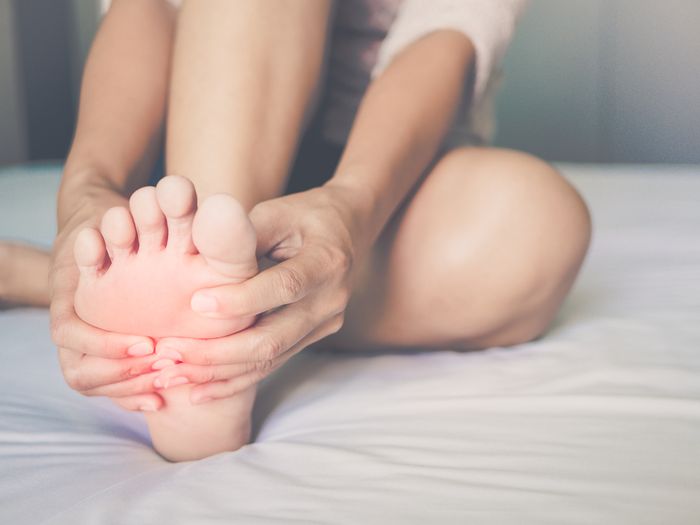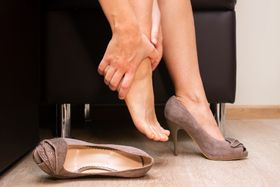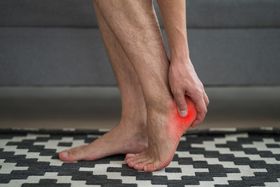What Causes Middle Foot Pain and How to Get Rid of It
Updated January 26, 2024.

Before knowing the causes of middle foot pain, let's first understand what is considered to be the midfoot. The midfoot is a pyramid-like combination of bones (metatarsals), tendons, and ligaments that form the middle part and arch of your foot.
Causes of Middle Foot Pain
Pain in the middle of the right or left foot is less likely due to a direct impact on the center of the foot, but more so due to the structures - more specifically, the bones, joints, muscles, ligaments, and nerves - composing the middle foot extension to the front part of the toes and the back portion of the heel and ankle.
Causes of Pain in the Arches
Foot arch pain can commonly be a result of a few conditions, such as:
- Plantar fasciitis Inflammation of the plantar fascia, the thin band of tissue that runs under your foot and connects the heel bone to the toes.
- Tendonitis Inflammation of surrounding tendons.
- Fallen arches (flat feet) The entirety of the sole touches the floor.
The reasons for these conditions, and others, are usually the result of any of the following occurrences:
- Ligament sprains
- Improper footwear
- Stress fractures
- Staying on your feet for long hours without any rest break
- Muscle tightness or weakness
Could Your Weight Be Causing Foot Pain?
Being overweight can certainly cause foot pain as it places more stress on your bones, joints, and muscles, altering their biomechanics. This could be directly related to discomfort and pain in the middle and bottom of the foot.
What Diseases Cause Foot Pain?
Foot pain can either be directly caused by underlying diseases of the foot or a secondary result of diseases of the knee and back. All three of these bodily regions function in one chain and are interrelated in their biomechanics.
Some of the conditions causing foot pain are:
- Osteoarthritis of the knees Wear and tear of the natural cushioning between joints.
- Plantar fasciitis
- Metatarsalgia Painful inflammation in the balls of your feet.
- Posterior Tibial Tendonitis Inflammation or damage to the posterior tibial tendon, resulting in pain on the inner side of the foot.
- Altered knee and foot posture
How Do You Get Rid of Midfoot Pain?
The first step in treating midfoot pain is getting yourself diagnosed by a physiotherapist or podiatrist. They can provide a conservative treatment plan that might involve taking care of your posture, regular exercising, using the correct footwear with a pair of custom-made orthotics.
Some of the prescribed remedies could be:
- Icing the area three times a day for 7-10mins using a frozen water bottle and simply rolling under your feet.
- Wearing a custom-made orthotic.
- Insoles for added support that makes your footwear fit properly.
- Taking frequent breaks if you are on your feet for long hours, especially if you suffer from plantar fasciitis.
- Stretching and strengthening exercises.
- Balancing rest and activity.
- Stabilizing the arches with proper footwear or insoles.
» Want to relieve your middle-foot pain? Checkout some insoles for flat feet for comfort
How to Stretch the Inside of Your Foot
For some immediate relief from midfoot pain, you can stretch the insides of your feet by carrying out the following steps:
- Sit comfortably on a bed with your legs straight
- Pull your foot towards you with a towel wrapped around the first half of your feet.
- Hold the pull for 30 seconds
Repeat the procedure for 3 sets, 3 times a day.
How to Know if Your Foot Pain Is Serious?
Look for the following signs and symptoms:
- Excessive swelling
- Inability to put any pressure on your feet
- Inability to do any movements
- Extreme temperature variations in your feet
- Unbearable pain
- Loss of sensation in the feet
All of the above point towards serious foot conditions that may need immediate treatment. It is suggested that you see a professional like a podiatrist or a physiotherapist sooner than later, as that will decide your prognosis and the speed of recovery.
You need only visit the ER in the event of severe emergencies, such as broken bones, extreme lacerations and bleeding, or other acts of violent trauma to your body. Otherwise, regular painkillers should be able to keep you functioning until you can visit a podiatrist, physiotherapist, or general practitioner.








